James Fadeley's Blog
June 24, 2016
Cultural Sabbatical for June
It’s been a while. Writing projects have kept me and the team remarkably busy. I’m happy to announce that we’ve finished the first round of edits for our novella series. More on this later, perhaps even as soon as next week. But for now, a little of what I’ve found time to enjoy.
 Books
BooksAs the fictional adventures continue, I have a tendency to rarely return to the same author within a year. This happens for many reasons; to prevent burnout, to keep my head filled with new ideas, and to rotate the geek-with-the-chic. Sometimes you get books that can blend those two things together, but this doesn’t usually happen until the novel transitions to the the screen, big or small.
But on that point, the “no author more than once a year” guideline was violated twice this year by Philip K. Dick, with The Man in the High Castle and my current read, Do Androids Dream of Electric Sheep? which is rapidly disappearing in my hand. The story is a blitz that is hard to put down, interesting in its own right though vastly different from its film adaption, Blade Runner.
PKD was, and pretty much still is, the “idea man” that made science fiction what it is today. While many such authors tend to focus on the more academic sciences, the beauty in Dick’s concepts are their psychological inspirations. His themes ooze and seep, capable of invading any genre no matter how timeless. It wasn’t so much about androids, but what androids tell us about us. It wasn’t the facts and dates of Nazi occupation of America, but rather how we live in such times, how we felt and why we do. PKD used his head to tell it from the heart.
On the subject of fast reads, I’m also rather impressed with the vanishing act performed with The Alchemist by Paulo Coelho, which I finished over last weekend. The book was the perfect mix of fantasy and fairy tale, tying its carefully woven mix of behind-the-scenes theological suggestions with the philosophies of its characters. It spoke with such depth that one’s life felt changed after reading.
 The final achievement on the literature front was Neil Gaiman’s American Gods which I purchased before even knowing about the upcoming television series. The novel was my first book by Gaiman (outside of the movie Coraline and the graphic novel The Dream Hunters with Yoshitaka Amano), and I truly appreciated the effort he put into researching and cultivating the world’s mythologies and not just the most common, such as Greek and Norse. The overall story is fairly satisfying on its own, although there is a sense that there should have been more to the story at times.
The final achievement on the literature front was Neil Gaiman’s American Gods which I purchased before even knowing about the upcoming television series. The novel was my first book by Gaiman (outside of the movie Coraline and the graphic novel The Dream Hunters with Yoshitaka Amano), and I truly appreciated the effort he put into researching and cultivating the world’s mythologies and not just the most common, such as Greek and Norse. The overall story is fairly satisfying on its own, although there is a sense that there should have been more to the story at times.
Perhaps that’s something that Starz will soon rectify.
While a part of me is looking forward to the book’s television rendition (considering it stars and ), there’s reason to be cautious. Especially since HBO attempted the script with three writers and just couldn’t get it down, eventually giving up. Still, although HBO generally employs good writers, the somewhat prematurely finished show The Leftovers would suggest that the channels struggles to engage its audiences in matters of theological consideration. Well, since we’re on that topic…
Television
On the live action front… I have a horrible confession to make ladies and gentlemen. I have never seen Orange is The New Black.
“What?!” Some readers might be screaming. “The show is amazing! How could you not see it?”
For me, Orange is The New Black is kind of suffering from a form of TV debt. Simply put, right now there is actually too much great television these days. HBO and Showtime used to have the corner to themselves, then AMC came along and proved that ordinary cable can deliver, followed swiftly by the lineups at Netflix. Now, it seems every channel has at least one hit show of some kind. USA has Mr. Robot (of which I’ve seen season one). PBS has Downton Abbey (currently I’m on the third season). The History Channel has Vikings (unseen but on the to-watch list).
With so much television out right now, it’s difficult to really catch up on golden oldies and prior seasons of current hits. OITNB is just one of those shows I put on the back burner to spend time on other projects. I may pick it up.
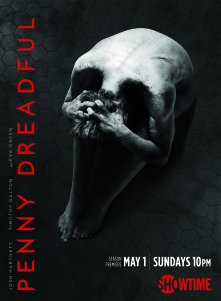 However, disappointment abounds that the third season of Penny Dreadful is the final of the series. I didn’t see this coming at all, but my understanding is that this was premeditated long ago. I’ve yet to begin watching it, although anyone who is familiar with my blog knows how much I’ve gushed over seasons one and two.
However, disappointment abounds that the third season of Penny Dreadful is the final of the series. I didn’t see this coming at all, but my understanding is that this was premeditated long ago. I’ve yet to begin watching it, although anyone who is familiar with my blog knows how much I’ve gushed over seasons one and two.
I intend to start Penny Dreadful shortly, but have been catching Game of Thrones first whenever possible. It’s not that I value the latter series any higher but simply because thoughtless fools on social media continue to ruin it, spoiling events if I don’t rush to see it. This has happened twice this year alone due primarily to memes. I am truly looking forward to the finale however, considering how awesome the last (ninth) episode turned out.
A couple of years ago, the last thing I expected was to be pulled back into anime ever again. But here I am, working my way through both the new and old; the third season of the classic Armored Trooper Votoms and Netflix’s latest, Voltron: Legendary Defender, of which I’ve seen the 69-minute initial episode (I will be watching the remaining, 23-minute episodes later). The short lengths of both series’ episodes, and the fact that they’re all immediately available, is a factor in my watching them.
I can’t really explain what it is that keeps me hooked on Votoms. At first glance, one would think it’s a show about mecha– large, combative robots often in a war-drama that justifies their usage. Mecha shows are often characterized by the “tech creep” of an arms race through improvements or new models, and a “boxing title bout” mentality between pilots. But Votoms bucks these trends hard.
After the signing of a cease-fire, war veteran Chirico Cuvie is tricked into a mission against his own side. Unable to trust anyone and now a fugitive, Chirico makes reluctant friends with a group of smugglers and lovable low-lives while trying to stay under the radar of a corrupt police force. But Chirico’s quest for survival transformers into a hunt for the truth, which threatens to reignite the fighting all over again.
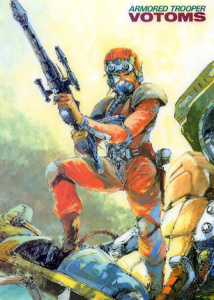 Gritty is the best way to describe the series. Jaded Chirico Cuvie barely forms attachments to anyone or anything, as he burns through ATs (Armored Troopers) like popcorn. They’re merely tools, to be used and discarded when no longer useful. They don’t upgrade as much as they adapt; swapping out weapons and parts to adjust for battles in space or underwater. Repairs and replacements are fairly grunt work and commonplace.
Gritty is the best way to describe the series. Jaded Chirico Cuvie barely forms attachments to anyone or anything, as he burns through ATs (Armored Troopers) like popcorn. They’re merely tools, to be used and discarded when no longer useful. They don’t upgrade as much as they adapt; swapping out weapons and parts to adjust for battles in space or underwater. Repairs and replacements are fairly grunt work and commonplace.
Voltron is the exact opposite in every way. While Votoms is gritty, cynical and hard science fiction, Netflix’s new series is more mythical, hopeful and exponentially more humorous. The disposable nature of the ATs gives way for the unique and important lions. The always-on-the-run survival exchanged for a defensive campaign. And yes, Votoms is for adults while Voltron makes itself appropriate for the whole family.
Cheekiness is Voltron’s best element, with plucky characters who can’t stop poking each other in the ribs. But peppered between the jibes comes a moderate amount of personal drama to punch up the plot lines; Pidge seeks his missing family while Shiro (a rechristened Sven from the original series) can’t remember his life while he was a prisoner of the Galran Empire. Elements like these are ideal for preventing the gladiator match episodes that the first series became known for.
But two weaknesses dog the new series. First, the humor can sometimes be ill-placed and over the top. And second, the pacing was fairly rapid in the rush to establish the universe, such as how everyone shares the same language or why the main characters could be trusted with a considerable amount of power.
Here’s hoping the Game of Thrones finale is one to remember this Sunday.


May 12, 2016
A Return to Form
So before I begin discussing some of the television shows of late, it is time for a confession. I’ve been seriously considering rescinding my policy regarding no book reviews.
The policy existed for a few reasons. There are concerns about conflicts of interest (promoting friends or nay-saying authors within my genre, etc) and also about the risk of creating enmity over honest critiques of works that fall below perfection. Although a heavy helping of tact and constructive criticism is essential to kaizen, there will always be those who are angered by the truth.
However there is a dearth of purposeful reviews. Product sites are host to star-ratings and plenty of unconnected praise, but they rarely go more than skin deep. What I’d like to see is true analysis; a discussion of themes, dissection of character motivations, breakdowns of any technical mistakes found by proofreading such as typos, misspelling or formatting concerns.
Therefore I’ll be establishing three basic rules:
The author or editor must request the review in the first place.
Friends and colleagues can request, but I will mention a prior relationship with them alongside the release.
The work must be available for purchase on at least one major outlet– This is to prevent trying to obtain “free” proofreading before release.
If anyone feels comfortable with these arrangements, feel free to contact me once the official page is available with my email. You can also simply comment here.
These reviews are spoiler free, but are lighter as a result.
Game of Thrones: Salt and Faith
 I’ve finally cracked the seal on watching the latest season of Game of Thrones. Two episodes in and something was very amiss. There was the story line to Dorne which feels hampered by a missing faction elsewhere (which was present in the books).
I’ve finally cracked the seal on watching the latest season of Game of Thrones. Two episodes in and something was very amiss. There was the story line to Dorne which feels hampered by a missing faction elsewhere (which was present in the books).
Likewise, the situation at the wall involving Davos Seaworth () seems to have materialized from effectively nowhere, resulting in deal-making with someone he ought to hate. This proved frustrating personally as Davos is one of my favorite characters.
These incidents are justifying my concerns that deviations and omissions from the source material are starting to hamper the series. Thus the screenwriters have begun hot-wiring threads together, hoping to keep the engine running. Yet the 10-episode format limits available time to smooth the wrinkles of these transitions.
George R.R. Martin’s novels give the impression that he’s fairly good at avoiding pointless tales and subplots. Even the things that seem unconnected (and there are many, many such elements) often connect and trigger events down the road, although sometimes these have to be taken with a hint of salt and faith. Why the screenwriters didn’t respect this more, I cannot say. But their hastiness instills me with patience for Martin as he carefully crafts the final installments.
The book series is, after all, his Magnum Opus.
This is not to say that this season has all been bad. Watching a childhood dream come true for Tyrion () on screen was rather amazing. And Daenerys’ ()complicated situation has my full attention. It simply maybe one of those moments when a few bad scenes must be overlooked to arrive at an otherwise good season. Time will tell.
The 100: Murder Made More
 Going from fantasy “past” to science fiction “future,” I’ve finally cracked the code that is The 100.
Going from fantasy “past” to science fiction “future,” I’ve finally cracked the code that is The 100.
There has been a trend where the first few episodes seem to have it rough, with character connections rampantly making or breaking. But as the story gets closer to mid-season, the alliances are finally sealed and the show tells the plot that it wants to tell… and quickly gets better for it.
This seems why the early episodes feel inorganic as the characters play musical chairs with pairings, the emotions they’re supposed to portray being jerked about. It could be that the producers have been trying to tweak and figure chemistry between its stars to best please its audience.
Another peculiarity has been the flip-floppery with regard to killing its darlings. In the prior seasons, killing characters was sometimes a painful, drawn out affair. This season saw sudden deaths claim two characters from the show’s dramatis personæ– one who resulted in a fair amount outrage.
Be forewarned, there are spoilers within this news link if the reader is curious.
However, the death of this person was absolutely necessary to advance the plot in a vital direction. And curiously, it seems we’ve also learned more about this character post-death than anytime while they were alive. And, as usual, it’s the pow of each season’s finale that keeps its fans coming back to next season’s slow start. That’s one thing we’ve learned to count on.
Unbreakable Kimmy Schmidt: Dangling Storylaces
 It was unclear what exactly was missing from this season of Unbreakable Kimmy Schmidt.
It was unclear what exactly was missing from this season of Unbreakable Kimmy Schmidt.
Only after being put side-by-side to the first season does the issue stick out. The first had an easier time weaving its most outlandish elements into the central plot. To this day, I still giggle over Titus Andromedon’s () amazing Pinot Noir music video and the autotuned remix of his “Gonna Be Famous” (which is exactly what happened as a result). And Kimmy () had her flashbacks to life in the bunker (occasionally revisited this season but not as often nor as rewarding). But this season, bizarre antics came more out of the blue, and were less memorable.
The plot-juggling was weirdly handled this time. Titus’ cliffhanger ending of last season was turned into an episode and then resolved with very little impact, although his follow up plots were simultaneously more interesting and entertaining. But less so for the rest of the cast. Jacqueline White’s () hunt for spiritual meaning kept jabbing at a political cankersore. Lillian Kaushtupper () labored against the gentrification effecting her neighborhood to no immediate effect for all thirteen episodes, although the ending suggested an intriguing thread for the third season.
Kimmy’s story lines were a Boggle board; first on her forbidden relationship with Dong before folding into deeply embedded psychological issues– resulting in animated scenes that were strange and out-of-place. Then there was the dynamic between her and Jacqueline that seemed little more than filler.
Her finale simply didn’t have that coveted “full circle” plot that Seinfeld and The League were renown for possessing. The first season of Unbreakable Kimmy Schmidt accomplished this in a less karmic way then those other shows, returning to the origin of the problem. But the second season simply didn’t try, arriving at some catharsis that doesn’t feel as meaningful as one may hope.
That’s all for now. Keep an eye out for Penny Dreadful and Halt and Catch Fire reviews next time.


May 5, 2016
Of Vikings and PAXes
PAX East began with our jaws on the bus’ floor. I will attempt to explain what we saw with a modicum of justice… and fail miserably to convey the experience.
The Boston Convention and Exhibition Center (sized at roughly six city blocks long by four wide) was located at the heart of the city, surrounded on three sides by channels. One could see the flashing demos of various games across a huge screen from the outside, and hordes of colorfully dressed fans lined up, waiting to get in. Between the center and the hotel, several sports cars rested inside the parking circle; Twin Lamborghini of an orange-turned-yellow color, two pink three-wheeled Polaris models and a few massive trucks. All of these wore markings of Blizzard’s Overwatch.
After perhaps 30 minutes of checking in, the skywalk between the hotel and convention center was traversed. I was permitted inside before the opening time thanks to a special Exhibitor’s badge furbished by Versus Evil, and was eager to check in with the booth. But once inside, the scale of the convention made navigation challenging. The upper two floors consisted of a handful of large theaters for hosting the panels, easy enough to understand.
The ground level was something else entirely.

This photo captures perhaps 20% tops of the sheer size of the show floor. The aisles were packed to the gills with flashing monitors, colorful displays, merchandise and posters, game demos and videos, manikins and hardware. Within not five minutes of the chimes sounding the show’s opening, the alleys and walkways were flooded with thousands upon thousands of fans, cosplayers, exhibitors, media personae and personnel, staff, crews and enforcers. Human traffic clustered and congested everywhere. Even the merchandise stores required fifteen minute lines to get in, although everyone around was excited and in high spirits so the time went fast. The fans were easy enough to talk to.
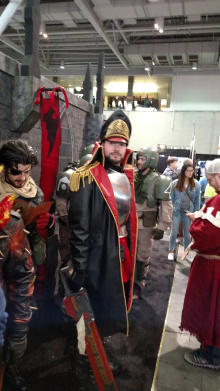 For Friday, the Versus Evil guys cut me loose to play. The first order of business was to hit up the Bethesda Store and score some gifts for friends and family, followed by the demo for Total War: Warhammer. Sega’s vision proved excellent, truly capturing the feel and appropriate scale of the conflict while remaining true to the themes and aesthetic… perhaps better than anyone else who has ever attempted it. The battle was perhaps twenty minutes long and perfectly eluded the sense of desperation and grimdark that is the hallmark of the Games Workshop’s fantasy universe.
For Friday, the Versus Evil guys cut me loose to play. The first order of business was to hit up the Bethesda Store and score some gifts for friends and family, followed by the demo for Total War: Warhammer. Sega’s vision proved excellent, truly capturing the feel and appropriate scale of the conflict while remaining true to the themes and aesthetic… perhaps better than anyone else who has ever attempted it. The battle was perhaps twenty minutes long and perfectly eluded the sense of desperation and grimdark that is the hallmark of the Games Workshop’s fantasy universe.
If the treatment of this game is anything to go by, then Dawn of War III will be faith rewarded for long time fans indeed. To probable delight of these guys.
Time was spent trying Zombie Vikings, the game that that Zach Weiner of Saturday Morning Breakfast Cereal helped produce. Guild of Dungeoneering and Let Them Come were also sampled and enjoyed. Still, there was simply too much to see, so the board and card games were briefly toured, the vintage video game vendors browsed and the props and demos admired. Time is the most valuable of currencies and there’s never enough to spend.
For Saturday was the big day.
Arriving at the panel a tad too late to get a front row seat, the opportunity was not wasted to snap several photos of the Stoic Studio guys on stage. In order from left to right was Technical Director John Watson, Art Director Arnie Jorgensen, Technical Designer Matt Rhoades, Lead Writer Drew McGee and Composer Austin Wintory. After a comical trailer by Kris Straub (contains spoilers), they spoke about the challenges and efforts of their latest title.

Their conversations sparked intriguing lessons, particularly how Austin wrote music based on Drew’s story, which in turn prompted changes to Austin’s tunes. Considering this, if two elements of a game are “speaking” to each other, then there was probably reactionary work done on the technical and artistic side as well. This could have meant a four-factor (art, music, story, tech) feedback loop of on-going innovations.
Although point of interest was Austin’s discussions regarding the music of series. Not just a composer but a full musical scholar, he explained how there was little historical understanding of exactly what Viking music sounded like exactly. And how this permitted a degree of freedom to craft based around discovered instruments without any clear instructions or reliable knowledge of their application.
After fan questions came the cosplay provided by the talented Danica Rockwood, Lady Devaan and especially the Dredge costume of Jackie Craft.
Awesome #BannerSaga #Cosplay at #PAXEast @Official_PAX pic.twitter.com/t7Gud03gig
— Versus Evil (@vs_evil) April 23, 2016
Seriously @ODanicaRockwood killed it ad Alette. All the @BannerSaga cosplayers did. Amazing time at #PAXEast pic.twitter.com/tkqN8b0vFh
— Austin Wintory (@awintory) April 24, 2016
At 11 am was my time to shine, and I hurried down to the booth for the first novel signing of my career; 200 printed copies to be given out to promote the game. Waiting at the booth for the set up, I thought back about the few other book signings I attended in the past. Which authors made me feel awesome about reading their stuff? Who were the writers whom I remember the most fondly meeting?
There was Gav Thorpe, who listened to me explain how much I loved his 13th Legion trilogy enough to carry it over the Atlantic Ocean for his autograph. Clint Lee Werner, who had intriguing discussion points about where he gets his ideas. Chris Wraight, who was the nicest guy I had ever met. And Sarah Cawkwell, who encouraged me to keep writing.
I hadn’t realized it until that moment, but they had taught me how to handle visitors of book signings. I did my absolute best to keep smiling and finding points to engage people, and to always start with asking their names and writing it down in order to remember and use it when parting. This made it easier to remember people, like the friendly PAX Enforcer Malachi who dropped by again on Sunday to shake my hand.
Whenever possible, points of shared interest were discovered; the recent season of Daredevil, the games we enjoy, our favorite things about the Banner Saga. I knew there was a line of waiting people, but I also really wanted to try and give anyone kind enough to drop by an experience that would (hopefully) keep them coming back.
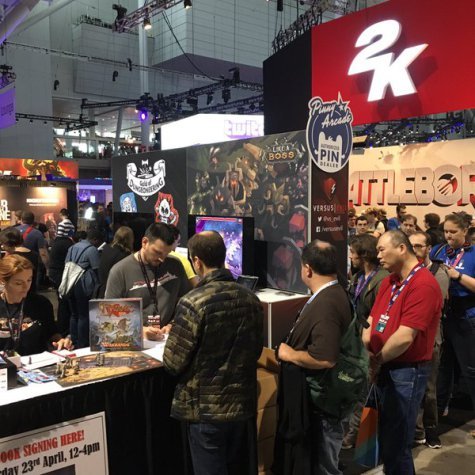
Whenever there was nothing to go by, discussion arouse regarding the book (“It’s a prequel– No spoilers. You don’t have to have played the first game but I highly recommend you do!”), or encourage them to play the demo (“It’s around the corner, try it! You’ll get a free pin!”) If nothing else, there was PAX East itself and what we hoped to see. Whenever met, encouragement was given to other writers, artists and hoping-to-be game creators to keep at their craft. And keeping tabs on KickStarter video for the Banner Saga: Warbands board game proved wise, as answers were rendered basic questions about it. It helped to be as excited for the game as anyone else who inquired.
Although four hours were set aside for the signing, I decided to remain an additional 30 minutes so any last minute folks could have a chance to grab a copy. By the end of Saturday, more than half of the books were gone. Checking back the following morning to see how well we did, there were perhaps 40 or so copies left to hand out before 11 am.
In the end, the event was a real taste of what it was to promote and market side of the writing business. The experience was actually fun and something I’d relish doing again someday.


April 15, 2016
“The Gift of Hadrborg” Out Now!
The big day has arrived. The Gift of Hadrborg is finally available for eBooks on Amazon.
Based on the best selling game from Stoic Studio and published by the hardworking folks over at Versus Evil, the novel is a prequel tale that takes place before the events of the first Banner Saga. The story follows the efforts of Eirik, an undercover agent in service to the Governor, as he sabotages the gang-epidemic across the crime-riddled city of Strand. However his successes only stop the lowest tier of thugs and lowlifes, treating the symptoms but never the cause as the most organized elements manage from afar. But when a trio of strangers arrive followed by a known felon, Eirik is embroiled in an all-encompassing conspiracy that threatens to topple the city itself.
Packed with political intrigue, action, a pulsing plot and complex characters, The Gift of Hadrborg is an great starting point for uninitiated fantasy readers as well as an awesome supplement for fans of the games.
And if you happen to be heading to PAX East this year in Boston, be sure to checkout the panel for The Banner Saga 2 which will host game directors Arnie Jorgensen, John Watson, Drew McGee, Matt Rhoades and composer Austin Wintory. I’ll be signing physical copies on Saturday at the Versus Evil Photobooth before and after the panel– if you don’t download a copy for the flight to Boston, be sure to get the book for the return home!
Available now for eBooks on Amazon. Print edition coming soon. For more information be sure to follow Stoic Studio and Versus Evil on Twitter.


February 22, 2016
Journal, February 22nd
It’s Monday. A calmer weekend has passed, with no all-encompassing plans. We watched both Bridge of Spies and the laugh-riot that was Deadpool. If you can stomach slightly over the top violence, catch it– it’s as hilarious as people say. I also finished reading Harry Potter and the Deathly Hallows wrapping the series which, yes, I had never read before.
On the writer’s front, I have a manuscript that’s about 90% complete, over 7,500 words. The story kept growing, as the spy games and world building became more interesting and worth telling. This new piece is being crafted alongside another that Andrew is composing, as part of an ongoing challenge between us to try and submit to short story openings together. Our stories will be loosely connected yet independent enough of one another to stand alone if only one of us makes it.
Paired writing is something I really enjoy when teamed writers are on the same page. My experiences on fan fiction boards of the past tended to be somewhat… flaky, about this. But Andrew is a fantastic partner with regard to dependency and punctuality.
The challenge is also important to me; I’ve noticed that there’s a huge gap in my publishing schedules fast approaching. Fox Spirit’s recent releases have left only two short stories in my “soon to be published” queue, due to a combination of larger works (a novel and a few novellas) and a few rejected or unfinished manuscripts. Although I’m glad for larger works going on, I’m making an effort to keep smaller pieces in circulation.
Next month marks four years since my first paid piece was published. Four years of trying to expand the bibliography, trying to move up and on to do more as a writer. Despite a major success, the rest of last year has been full of hard knocks. My output has been dropping partially because of the aforementioned projects, but also due to the remarkable amount of research going into the latest submissions. The hardcore efforts have stung however, because despite twice the effort the results have been horrid disappointments. Promising ideas and concepts, even encouragement and interest from the editors… only to be rejected anyway.
The words have been flowing more slowly as of late. I believe the reason is because I’m looking to be concise, more efficient with what is said. With every section I find myself weighing the value of what is told. On one hand, it makes it easier to avoid the Stieg Larrson approach, where he gives too much information and details about the most utterly mundane things. On the flip side, some of those details are worth sharing, painting an image of fictional person’s preferences and aspects of the setting.
Sometimes it feels like proper character development and world-building is less in the appearance of something and more in the tale of why it exists in the first place. My latest piece feels like a solid example of that, in that it’s not so much a short story but rather a dozen historical vignettes that paint the portrait of the city in question. I’m not a vested history buff or anything. It’s just that if you stare at a city without digging into its past, they often look the same. People can be much the same, rather visually bland within crowds until you get to know them.
Perhaps that’s all many novels really are. A composite of a thousand micro-stories, with the main plot just the latest tally to be added to that list…


February 16, 2016
Fox Pockets: In An Unknown Country Out Now!
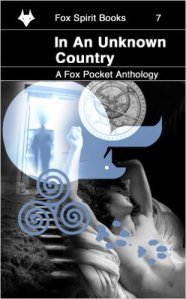 At long last, my favorite contribution to Fox Spirit’s micro-anthology series is available now! Fox Pockets: In An Unknown Country contains “Stroppendrager,” a historical fiction piece by yours truly.
At long last, my favorite contribution to Fox Spirit’s micro-anthology series is available now! Fox Pockets: In An Unknown Country contains “Stroppendrager,” a historical fiction piece by yours truly.
I love writing historic fiction. Based on information on hand, I do my best to try and concoct a story around the facts rather than try and warp facts to fit my story. This particular yarn tells the origin of the “Noose Bearers,” whom are celebrated every summer by their respective guild. The reenactors dress up in white undershirts, ropes hanging from their necks as they are escorted down Gent’s streets by pike-wielding guards. This act by the Guild of Noose Bearers recounts the Revolt of Ghent in 1539, when the entire city refused to pay the increased taxes following the Italian Wars. Unfortunately for the city’s guilds, the revolt came to an end once Charles V showed up with 5,000 soldiers under his command.
Since the manuscript was finished, more translated research material has become available. The new information would have peppered the story with more insight of the times, such as the guilds strong involvement in the uprising and the political maneuvering to try and maintain Ghent’s independence. However, I believe the story personal elements of “Stroppendrager” remain unscathed. The central themes function independently of these new facts and do not invalidate the plot. The main character’s patriotic views and his counterfoils theological concerns still serve a thematically satisfying tale that could adapt to the facts rather than the other way around.


January 13, 2016
Ginger Nuts, Specters and TPS Reports
“In a way, we were robbed thrice.”
Earlier today, the review site The Ginger Nuts of Horror released an update regarding the situation at Spectral Press. As usual, I advise anyone of interest (particularly fellow writers) to read the original post before continuing with my observations on the matter.
But for those who just need a recap, Spectral Press has declared itself in financial straits. Owner Simon Marshall-Jones also mentioned health problems, to which I wish him health and speedy recovery. But with regard to the former issue, The Ginger Nuts of Horror will be altering its policies.
They will no longer review works that offer only exposure.
They will firmly vet small press publishers to prevent abuse.
They have shown concerns regarding fair payment.
I applaud points one and two with alacrity. The third point I’d like to discuss because of vagueness in need of redress. Particularly on the subject of the token payment system (ah yes, TPS reports) and business growth.
My friends and I have all made erroneous steps once or twice in the (mine)field of the small press industry; tiny businesses who exist thanks to the ease of Amazon’s print-on-demand and eBook publishing services. We know better than to submit for “exposure.” And any publisher who too readily accepts our work likely has a quality problem. Despite our cautions, we still made mistakes.
 We have been victim of at least one publishing company who failed to make the promised royalty payments when it formally closed its doors. Not only did they fail to deliver the meager earnings owed, but the returned stories could not be published anywhere without the less valuable “reprint” status.
We have been victim of at least one publishing company who failed to make the promised royalty payments when it formally closed its doors. Not only did they fail to deliver the meager earnings owed, but the returned stories could not be published anywhere without the less valuable “reprint” status.
These stories were some of our best work too, now reduced in value. And worse, because these anthologies were on-and-off the market in a mere four months, even the promised exposure failed to really materialize.
In a way, we were robbed thrice.
It’s nothing new however. The problem of troubled publishers failing to pay their authors is far older than Amazon. Even legends like Robert E. Howard suffered. When the author died in 1936, Weird Tales still owed him at least $800. Adjusted for inflation, that’s around $13,800 by today’s standard. A serious chunk of change.
In an ideal world, we would be paid the professional rate of $.05 a word, at the very least. But as book sales drive compensation, it’s not uncommon to settle for something less if only to get both companies’ and authors’ feet in the door. As I read and reread The Ginger Nuts’ statement, I began to wonder what and how they defined fair payment.
Payments from small press generally come in two forms: royalties and token, both with boons and burdens.
Royalties cost the company little up front, as they instead divide and deliver percentages of the sales to the authors for as long as the book remains on the market. If the book does well and the percentages fair, the authors will probably make better than a token payment. For the companies, royalties also encourage authors to get out there and sell the books direct, as they have an on-going incentive. The downsides? Royalties can be nil if the book doesn’t sell, and the author and company could end with nothing. Plus, royalties have to be paid periodically.
Token payments come with a whole different set of pros and cons, an upfront payment for temporary publishing rights. The downside is that it’s an upfront cost to the company, while the authors gain the benefit of immediate pay. The authors have less incentive to promote their work– they’ve already been paid. On the flip side, once the book surmounts those costs, the company begins earning pure passive-profit that the authors never see.
 I can tell you from experience that capital-intensive token payments are much easier for all parties. After the Bolthole anthologies were released, I had to hound a couple of authors every few quarters, telling them to update their rejected PayPal contact information. Calculating totals wasn’t fun.
I can tell you from experience that capital-intensive token payments are much easier for all parties. After the Bolthole anthologies were released, I had to hound a couple of authors every few quarters, telling them to update their rejected PayPal contact information. Calculating totals wasn’t fun.
I also learned to set aside capital from my pocket to pay authors as on-time as possible– PayPal can have delays three to five day long when transferring funds. Geez. I almost forgot I have to do that this week for Far Worlds.
But I digress.
Still, there is a potential problem with the token payment system. When a publisher is young, a low token payment is probably fine– If authors don’t like it, they shouldn’t submit. But persistently low payments are telling. If a publisher opens in 2012 and offers $10 for short stories, and in 2016 they’re still offering only $10 for submissions, then either:
A) Check with the prior authors and see if they’ve been paid. If they haven’t been, there’s a good chance the publisher is hoping the next release will be a strong enough ROI to cover all debts. In which case, don’t trust them.
B) The publisher is barely breaking even, which is neither good nor damning.
C) The publisher is making bank from the difference of cost against profit.
A is the worst case scenario. Obviously an author shouldn’t submit to them, as the publisher is outright gambling that book sales will turn around their situation. B (if you can prove it) is not great either, and should lead authors to question the publisher’s direction.
But of these options, C is the most complicated. It means that the publisher is actually growing, but is milking the situation instead of upping payments for the benefit of their authors. Admittedly, publishers need capital to grow; to pay for site improvements and better art, to launch bigger projects and so forth. Yet they’re not helping their authors grow with them. If evidence suggests C, quality authors could and should go elsewhere.
How do you prove B versus C? Well, it would help if publishers were more forthright about their sales data. If not, you can try to make estimates against the book’s sales rankings on Amazon. You can also watch their website. Did they suddenly get way better looking banners and artwork? Are they obtaining costly features and plugins? Did they just procure an author you’ve actually heard of for a novel?
But before you jump to conclusions, dig deeper. Make sure that one of their staff isn’t an experienced web developer or artist. Or that they weren’t already friends with the author long before the company came into existence. Or perhaps they’re infusing their own, private money into improvements (in which case, they’re bloody awesome). If they’re using available resources and skills to get out of option B, you can’t blame them.
But if you are one of those C optioned publishers reading this, I’d advise you to raise your rates. If your response is that it’s a hobby and not a business… well, you’re going to have a bad time. Because for authors and writers out there, it is a business. It’s our business.
Treat it with respect or walk on.


January 11, 2016
Golden Bowie Land
 I’m frustrated and angry. Not a single word of literary concern was written this weekend. Instead, a heavy chunk of my time was invested trying to deploy a new website. The efforts left me too mentally exhausted to really write, although I did go through and accept a number of edits for a completed novella. And what I learned about Linux administration will be valuable for my career, despite my intentions to apply these skills in a publishing capacity.
I’m frustrated and angry. Not a single word of literary concern was written this weekend. Instead, a heavy chunk of my time was invested trying to deploy a new website. The efforts left me too mentally exhausted to really write, although I did go through and accept a number of edits for a completed novella. And what I learned about Linux administration will be valuable for my career, despite my intentions to apply these skills in a publishing capacity.
These late night efforts have left me in the surreal half-asleep trance even while I sit at work, listening to “Blackstar” by David Bowie. Likely due to my sleepless state, my mind simply rejected news of Bowie’s death this morning. I don’t mean skeptical, wait-until-the-internet-corrects-itself stoicism, but firm refusal to believe the facts. My obstinate reaction shocked me.
I considered why I felt as I did. In my twenties, I purchased his album Scary Monsters (And Super Creeps). Yet after listening, I did not understand him. His music and art were always unique and comprehension wasn’t always automatic. So many bands and singers try to find a particular sound that takes them to success, reproducing it with appealing variations for consumer consumption. But Bowie seemed impossible to emulate, even by himself. For all the music he concocted over the years, how often did any piece sound like the others?
The realization stopped me cold in my words. Even when unrecognized, David Bowie was always there.
Always.
 There were the overt hits and singles. In ’69 came “Space Oddity.” The year before I was born, Bowie teamed up with Queen to sing “Under Pressure.” And he changed and evolved over the years, such as when he teamed up with Trent Reznor for “I’m Afraid of Americans.” These are merely examples that readily come to mind, but the sheer body of work is staggering; 27 studio albums, 111 singles, 46 compilation albums.
There were the overt hits and singles. In ’69 came “Space Oddity.” The year before I was born, Bowie teamed up with Queen to sing “Under Pressure.” And he changed and evolved over the years, such as when he teamed up with Trent Reznor for “I’m Afraid of Americans.” These are merely examples that readily come to mind, but the sheer body of work is staggering; 27 studio albums, 111 singles, 46 compilation albums.
When future generations of musical scholars study his discography, “Where should I begin?” is a philosophical debate of which few, if any, could be prepared.
But even when not present in body or voice, his music was felt, such as the acoustic versions sung in The Life Aquatic with Steve Zissou. His influences trickling into the acts and lyrics of dozens of artists, perhaps Lady Gaga the most. It all illustrates the sheer importance of the departed; David Bowie was not so much a person as he was, and still is, a pillar of human civilization. A column upon which rests our perceptions of the modern world.
Guys like me took him for granted.
And Bowie’s influence was never limited to music. While most people best remember him for his role as the Goblin King in Labyrinth, I was more attuned to his unique portrayal of Nikola Tesla in The Prestige. Christopher Nolan was so determined to have Bowie for that role, the director flew out to New York to pitch it to him in person. The act moved the singer to accept Nolan’s offer, even after initially declining.
 There are very, very few who could claim to know all the phases and periods of the Bowie era, from his beginnings in the early 60’s to Blackstar, his final album. The shifting costumes, various masks and rotating personas required listeners of the most eclectic tastes and hunger for the nouveau. Yet simultaneously, it is impossible to be oblivious of his importance, nor to admire at least one decade of his time. Some have called him a chameleon and the comparison fits… at least until one examines the sheer scope of what he accomplished. Then you know he was more than that.
There are very, very few who could claim to know all the phases and periods of the Bowie era, from his beginnings in the early 60’s to Blackstar, his final album. The shifting costumes, various masks and rotating personas required listeners of the most eclectic tastes and hunger for the nouveau. Yet simultaneously, it is impossible to be oblivious of his importance, nor to admire at least one decade of his time. Some have called him a chameleon and the comparison fits… at least until one examines the sheer scope of what he accomplished. Then you know he was more than that.
He was elemental.
Like water, always taking new shape. The rain that makes the storm, the flurries of the blizzard and the endurance of the ocean. Beneath the madness of garish colors and the ripples of his psychological depths was something ever evolving, ever growing for 54 years. There will be no acts that are quite what he is — not was, for he has earned an immortality reserved solely for the artist.
After him comes only the note of silence, for none could fill his place. And his death conjures chagrin, for the world he sold is now a far less interesting place.


December 22, 2015
Things in the Dark, Out Now!
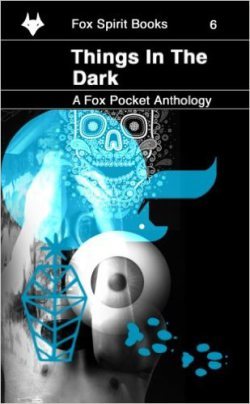 Another short by yours truly is available in Fox Spirit’s latest release, Things in the Dark, now available in print at Amazon.
Another short by yours truly is available in Fox Spirit’s latest release, Things in the Dark, now available in print at Amazon.
There’s a bit of history behind “Selachiamorpha Caesar,” my addition to this anthology. Originally, I wrote a fairly different story to submit to Fox Spirit’s Under the Waves. That tale was a simple one about a boy who enjoys diving, having learned from his now-missing aunt. Originally I envisioned a two or three part mystery for inclusion in a few of the themed Fox Pocket anthologies.
That idea first came about more than two years ago, just before a trip to Australia. During that vacation, I (as an American) had a once-in-a-lifetime chance to go scuba diving in the Great Barrier Reef. The experience was my first time diving, overwhelming as I tried to take pictures, learn the art of breathing carefully, maneuver in a rubber suit and try not to touch anything.
All of this at the same time. It was quite a juggling act.
Before I boarded the plane however, I did a fair amount of research into scuba diving to get a grasp of the basics and the theory. That knowledge formed the basis of “Bottom Dwellers” which I submitted to Under the Waves.
Even as I clicked the send button to deliver that submission to Fox Spirit, I doubted it. Ultimately, there’s a point where knowing a good story from an uninteresting one becomes rather instinctive (although being able to explain why is an incredibly valuable skill). Despite knowing this, I submitted “Bottom Dwellers” anyway, in order to tell myself that I truly tried and failed rather than didn’t try.
The plot of “Bottom Dwellers” started by establishing the boy’s love of diving, then flows into a trip to Sydney to celebrate his birthday. His mother helps him dive in an area his aunt loved to explore, where he finds a long decomposed body. The police autopsy confirms the corpse is not his aunt, but was meant to add an element of mystery to be unraveled later.
Though I trusted that the technical details were there, I suspected the plot just didn’t have as much punch as I’d hope. It was one of those situations where the ending was probably the most interesting part, and everything that led to the climax seemed… perhaps a bit cookie cutter. If I rewrote it, I might have begun with the discovery of the body, filled in the emotions and details after the fact, and concluded by definitively connecting the corpse to the aunt in some way.
However, it was not a wasted exercise. The story itself was excellent practice. And I took the research and combined it with two different ideas into a completely new and unrelated tale which found its way into this anthology.
Spoilers follow.
The first was a concept I guess we can call “Protagonistic Projection.” Using the first person perspective, I carefully avoided any hints as to the main character’s sex and race. Although I’m pretty confident others have used this idea before in writing, my inspiration for it came from various sandbox games such as The Elder Scrolls V: Skyrim, where the player can create their own hero from scratch. Because the story is told directly to the reader, and the narrator has almost no interaction with other folks, I feel the concept works quite well.
And the second was the Selachiamorpha Caesar, Selachiamorpha meaning shark, and Caesar for king or even emperor. The shark of sharks. I did not know at the time about the “colossal cannibal great white shark” that the news would report around June of the following year (I double checked my Gmail records; the story was submitted on May of 2013.) The fictional and non-fictional sharks aren’t exactly the same. My version was perfectly willing to eat other sharks but whether or not it would eat its own wasn’t specified. However I cannot say the coincidence is really a surprise to anyone, however.
No matter how much we learn, the ocean always seems to have more secrets for us to discover…


December 15, 2015
Jessica Jones Season 1 Review

This review contains spoilers.
This reviewer has very little prior knowledge of Jessica Jones or Luke Cage, although he is familiar with the Purple Man from early-era Daredevil comics. As such, these reviews are against the material as presented on television. And on that note, Marvel’s knack for turning little known heroes and heroines into amazing small screen series cannot be understated.
Like its movies and series before, Marvel’s success continues to hinge upon top notch casting decisions. stars as the titular character, a former super hero turned private investigator with a tragic past. Ritter perfectly captures the essence of a woman tired of the altruism of the superhero gig, and has nothing to show for it but scars caused by the violent shattering of good intentions. Foul mouthed, sardonic and utterly jaded, Ritter successfully blends her comical wit and slyness from Don’t Trust the B– in Apartment 23 with the dramatic talents she proved to possess in Breaking Bad.
Most of Jones’ work involves the typical, misanthropy-inducing sleaze that comes with the occupation; gathering dirt for clients to ease their divorce proceedings. Jessica’s lowness is further highlighted by her more successful associations. These include her adopted sister, famous talk show Trish Walker, and high-powered-high-profit Attorney Jeri Hogarth who is the source of most of Jones’ dubious clients.
However, Jessica haunts her past as much as it haunts her. She all but stalks Luke Cage, the owner of a local bar, for reasons of her own. And the rest her time is spent as inebriated as possible. Yet her path changes trajectory when she’s charged with locating a missing girl named Hope Shlottman ().
This chase eventually crosses paths with Kilgrave, better known as the Purple Man, a sociopath from Jessica’s past with the ability to control minds. Determined to hurt Jones’ for the pain of her abandonment, Kilgrave uses his powers to frame the kidnapped Shlottman for the murder of her parents.
plays the role of Jones’ tormentor and nemesis Kilgrave. While Marvel’s movies seldom possess the time to carefully cultivate their villainy, their small screen work truly makes their bad guys amazing to behold. Just as did with the Kingpin, Tennant makes the Purple Man shine with his warped sense of morality and refusal to accept responsibility for the actions partaken by those under his control. Driven by injured pride and obsession, Kilgrave returns from Jones’ past to try and reclaim what is “his.”
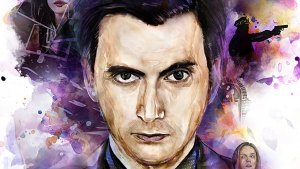 One of the best elements of Jessica Jones has to be the unorthodox approach to handling the origin story. Too many comic-derived works take the Fantastic Tales approach of laying out the source of a protagonist’s abilities and heroic drive very early. And often rehashing it again and again whenever a new print starts or whenever a fresh introduction is required for new and expanding readership.
One of the best elements of Jessica Jones has to be the unorthodox approach to handling the origin story. Too many comic-derived works take the Fantastic Tales approach of laying out the source of a protagonist’s abilities and heroic drive very early. And often rehashing it again and again whenever a new print starts or whenever a fresh introduction is required for new and expanding readership.
Rather, series creator wisely chose to wrap Jones’ past in two layers of mystery at least; the origin of Jones’ powers (to be discussed later) and Jones’ sordid history with Kilgrave and Cage, which is the center stage of this season.
For Jessica, Hope and a cast of other characters (including as Jones’ drug-addicted neighbor Malcolm), being a Kilgrave-survivor is a point of psychological intrigue. Kilgrave’s abilities raise unspoken questions regarding the nature of free will, as his victims are conscious and aware of their disturbing, involuntary actions, often voicing regret and remorse even as they obey. Yet the most horrible aspect of it is the sense of relief some of Kilgrave’s victims feel, assigning responsibility for their acquiesce to the man in charge. This psychological phenomenon is a carefully explored hypothetical that fairly puts the series in the realm of true science fiction.
Indeed, Kilgrave’s influence is felt absolutely everywhere and by everyone, no matter how much they try to elude him to deal with their own subplots. Those threads are a point of brilliance for the show. All the major characters are luckless enough to be caught by the Purple’s Man’s entangling web, which no one passes through without injury or consequence. And every subplot save one ties back into the centerpiece. Chekhov’s gun is observed and obeyed but the results aren’t without twists that shock and surprise.
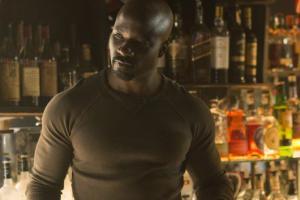 Of those subplots, perhaps the highest praise could be paid to as Luke Cage. Like Jones, he is haunted by his past; a dead wife (at Jones’ hands and Kilgrave’s command), which led to a stint in prison where he achieved his powers of indestructibility. The original character is often classified as part of the blaxploitation era of the 70s, but care and vision had been given to the role’s reconstruction since then to stand above and beyond stereotypes.
Of those subplots, perhaps the highest praise could be paid to as Luke Cage. Like Jones, he is haunted by his past; a dead wife (at Jones’ hands and Kilgrave’s command), which led to a stint in prison where he achieved his powers of indestructibility. The original character is often classified as part of the blaxploitation era of the 70s, but care and vision had been given to the role’s reconstruction since then to stand above and beyond stereotypes.
Cage appears in roughly a third of the series, but his application moves the plot forward without overshadowing or distracting from Jones, while imparting depth and intrigue on his own. Colter’s passion for Cage has inspired this reviewer’s increased interest in the character’s forthcoming series, effectively selling it long before production finishes.
Then there’s Jeri Hogarth, portrayed by . While the role was originally that of a man, Anne-Moss engaged the character with a sense of powerful rottenness that makes Don Draper of Mad Men look utterly meek in comparison. Hogarth’s story involves a tricky divorce from her wife for the love of her secretary, the strains of which grow until they are masterfully woven into the main plot. Her self-interest veers on the edge of antagonism even, such as preserving a sample of Kilgrave’s DNA for future study, even as the consequences turn karmic. Despite the tragedies that are inflicted on Hogarth, these traits are unlikely to have been erased, and one cannot help but wonder if she may become a villain.
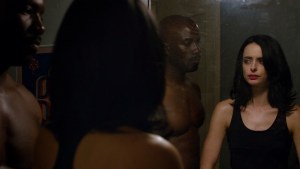 While Cage provides a complicated love interest for Jones and Hogarth the professional and legal expertise, emotional support stems from her sister Trish Walker (). Grateful for Jessica’s help in escaping the clutches of their overbearing, fame-oriented mother, Trish’s attempts to aide her sister invoke the ire of Kilgrave. It’s here that Walker’s story interlaces with Officer Will Simpson ().
While Cage provides a complicated love interest for Jones and Hogarth the professional and legal expertise, emotional support stems from her sister Trish Walker (). Grateful for Jessica’s help in escaping the clutches of their overbearing, fame-oriented mother, Trish’s attempts to aide her sister invoke the ire of Kilgrave. It’s here that Walker’s story interlaces with Officer Will Simpson ().
Turned into a pawn for the Purple Man, Simpson regrets his attempt on the life of the popular talk show host, and he and Trish eventually begin a relationship while the try to help Jones. A former soldier, Simpson has applicable experience for such situations. But Simpson’s extreme methods prove frictional for the women, who need Kilgrave alive to prove Shlottman’s innocence. The polarizing situation eventually drives Simpson back into the arms of a group known as TGH, who supply him with drugs that cause his combat prowess to match the intensity of his increasingly unstable demeanor. Walker’s research into this issue casts light on the mystery of the origin of Jones’ powers, hinting that TGH was responsible.
 The remainder of the main plot proceeds as follows. Kilgrave’s attempts to manipulate Jessica fail, despite trying to exploit her past and Jones’ temptation to convince Kilgrave to use his powers for acts of decency. Kilgrave is eventually captured, and Jones discovers that she’s immune to his powers. Homework reveals that Kilgrave’s parents, inadvertently responsible for his abilities after trying to save his life from a disease, have been monitoring the situation from afar. Jessica involves them to build her case to the police.
The remainder of the main plot proceeds as follows. Kilgrave’s attempts to manipulate Jessica fail, despite trying to exploit her past and Jones’ temptation to convince Kilgrave to use his powers for acts of decency. Kilgrave is eventually captured, and Jones discovers that she’s immune to his powers. Homework reveals that Kilgrave’s parents, inadvertently responsible for his abilities after trying to save his life from a disease, have been monitoring the situation from afar. Jessica involves them to build her case to the police.
Kilgrave escapes by exploiting Hogarth’s desire for an amicable divorce, but only after he slays his mother. Simpson appears later and destroys the gathered evidence, believing it folly to involve the law. Hogarth leads Kilgrave to her wife, who is a doctor, in order to treat a wound. Through Hogarth, Kilgrave learns of the fetus (of which he is the father) that was taken from Shlottman and preserved for study. Disgusted, Kilgrave leaves Hogarth to face the vengeance of her wife, but is saved by her secretary. Freeing Shlottman by coercing a DA, Kilgrave offers the girl in exchange for his father Albert. However the deal goes sour for Jones. Shlottman takes her own life as Kilgrave escapes with his father.
Let’s pause in the recap for a moment. If there was any weakness in Jessica Jones, it was here in the tenth episode. Kilgrave’s final escape risked being one chase too many, one dangerous step beyond the limits of audience’s interest, fractured by the wasted efforts of Jones, Hogarth and Trish to prove Shlottman’s innocence. And for many viewers, the scene was nearly as heartbreaking as a murder in Game of Thrones. Although the final three episodes rebound the desire to continue, this particular episode felt prolonged and almost needlessly tragic. These two factors made the tenth episodes “AKA 1,000 Cuts” the most difficult to watch.
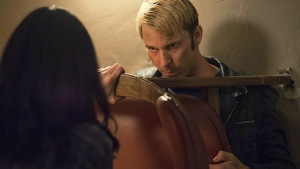 The skills of Kilgrave’s father are harnessed to improve his son’s abilities, while Simpson’s volatility proves too dangerous. Trish and Jessica are forced to subdue Simpson, who disappears. Kilgrave proves the depth of his new-found power by deeply programming Luke Cage to lure Jones into his trap.
The skills of Kilgrave’s father are harnessed to improve his son’s abilities, while Simpson’s volatility proves too dangerous. Trish and Jessica are forced to subdue Simpson, who disappears. Kilgrave proves the depth of his new-found power by deeply programming Luke Cage to lure Jones into his trap.
After rendering Cage dangerously unconscious with a shotgun blast to the face, Jones enlists Nurse Temple () to keep her friend alive while Jones and Trish pursue the Purple Man. With no choice and no one left to defend, Jessica tricks Kilgrave into getting close before snapping his neck. Hogarth uses the implausibility of the circumstances to get Jessica off the hook legally. After regaining consciousness, Cage flees. Jones is alone again with only Malcolm, while Trish, given aide by her mother, begins researching TGH…
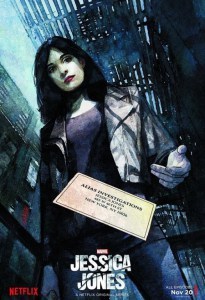 However, the plot line involving TGH was the aforementioned mystery that remains unresolved for now. The second season hasn’t been announced as of yet as Marvel’s The Defenders likely takes priority. However, it’s not impossible that Jones’ may make appearances in Luke Cage or the second season of Daredevil between now and then.
However, the plot line involving TGH was the aforementioned mystery that remains unresolved for now. The second season hasn’t been announced as of yet as Marvel’s The Defenders likely takes priority. However, it’s not impossible that Jones’ may make appearances in Luke Cage or the second season of Daredevil between now and then.
Compared to Daredevil, Jessica Jones feels the more superior show by a few increments. Daredevil was somewhat handicapped by the sheer number of villains it was saddled with, and had many faces and story lines to introduce or at least hint at, both for its own sake as well as setting up the forthcoming miniseries. Jones was more free to explore the character and her yarns against 1.5 villains, and as a result handled its material slightly better.
If the first season of Daredevil has taken care of all the heavy lifting, and Jessica Jones is any indication of what to expect from now on, then we have a lot to look forward to from Marvels’ television studios.






